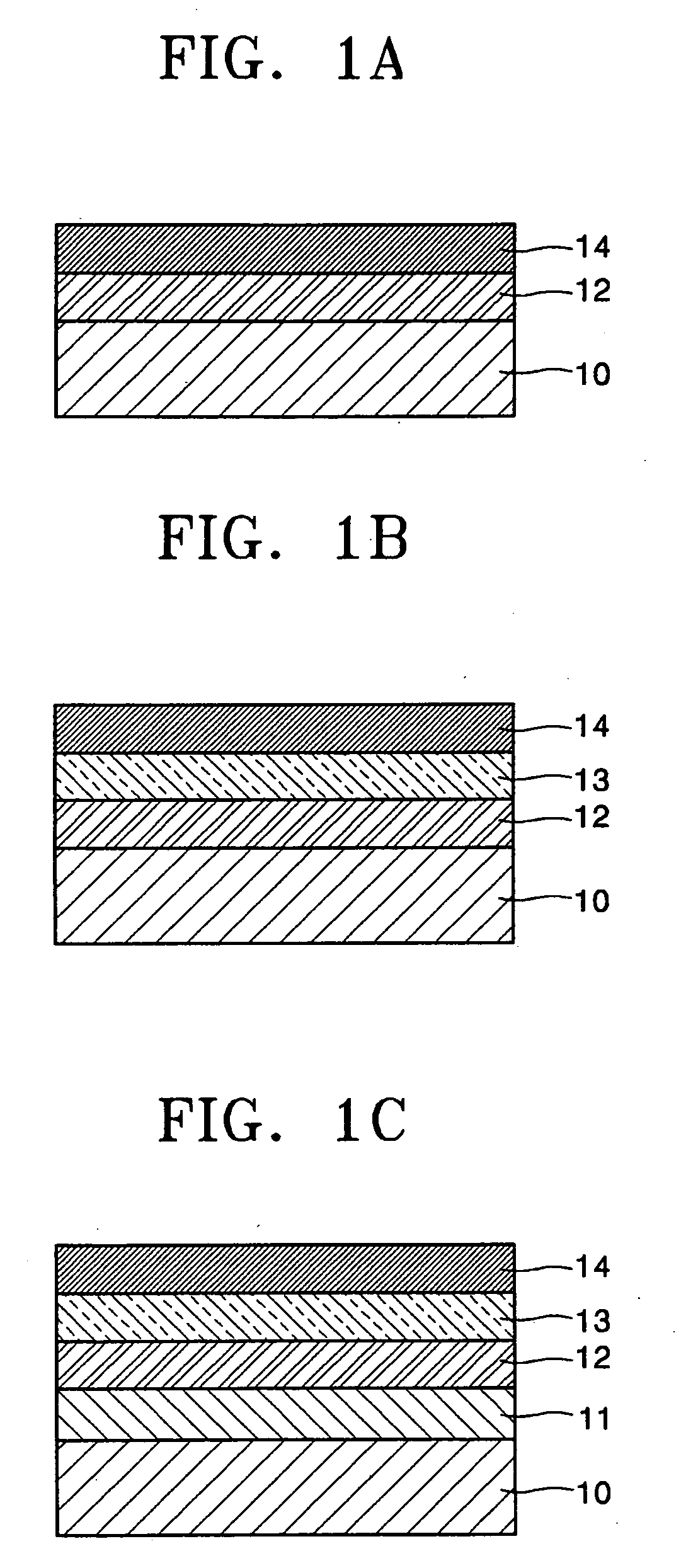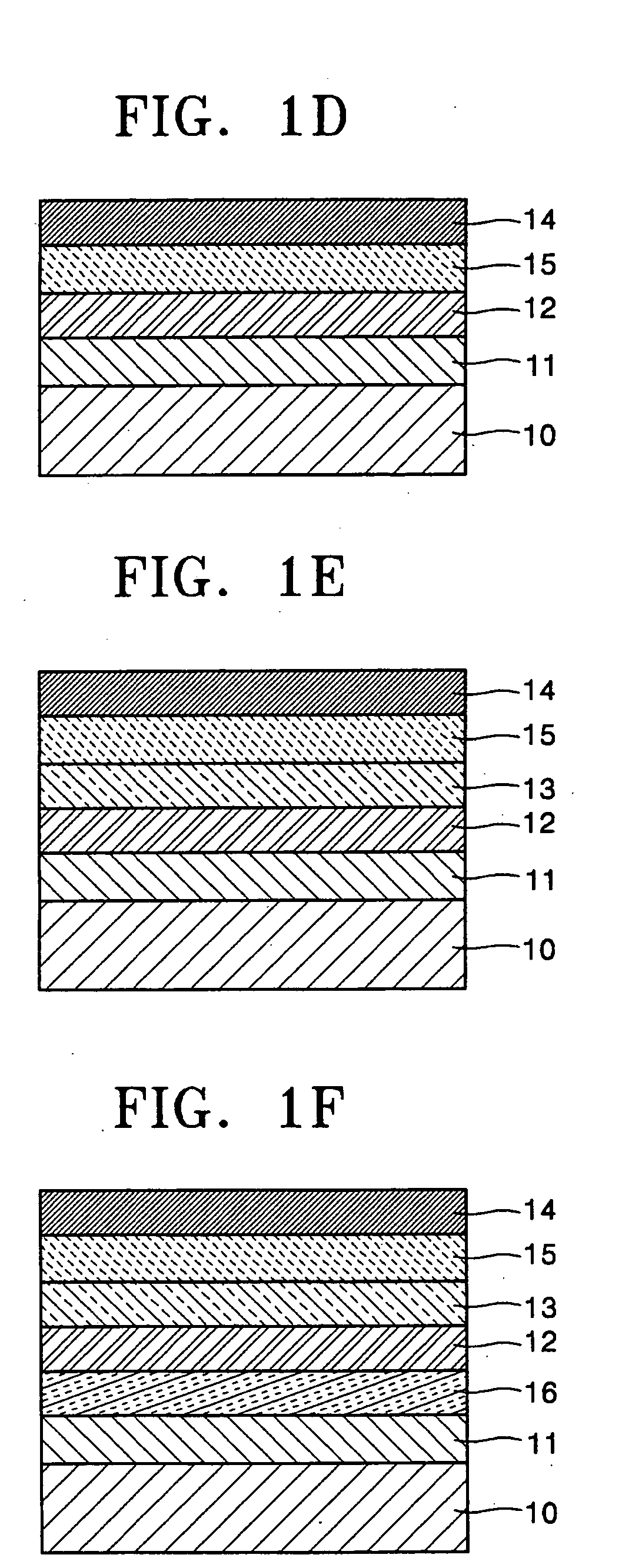Blue electroluminescent polymer and organic electroluminescent device using the same
a technology of electroluminescent polymer and blue electroluminescent polymer, which is applied in the direction of solid-state devices, discharge tubes/lamp details, natural mineral layered products, etc., can solve the problems of short life, low color purity of high-molecular weight organic electroluminescent devices, and insatiable improvement, etc., to improve color coordinate characteristics, improve driving characteristics, and facilitate transport charges
- Summary
- Abstract
- Description
- Claims
- Application Information
AI Technical Summary
Benefits of technology
Problems solved by technology
Method used
Image
Examples
synthesis example 1
Preparation of Polymer Composed of Repeating Units of Formulae 3 and 4
[0097] A Schlenk flask was evacuated and refluxed with nitrogen gas several times to completely remove moisture. Then, 660 mg (2.4 mmol) of bis(1,5-cyclooctadiene)nickel(O) [hereinafter, referred to as Ni(COD)] and 300 mg (1.9 mmol) of bipyridal were charged into the Schlenk flask in a glove box, and the flask was evacuated and refluxed with nitrogen gas several times again. Next, 5 ml of anhydrous dimethylformamide, 259 mg (3.2 mmol) of 1,5-cyclooctadiene (COD), and 5 ml of anhydrous toluene were added to the flask under a nitrogen stream. After the mixture was stirred at 80° C. for 30 min, 556 mg (0.072 mmol) of the compound of Formula 3 and 73 mg (0.008 mmol) of the compound of Formula 4 were diluted with 5 ml of toluene and added to the mixture. Next, 5 ml of toluene was added to the mixture while washing materials adhered to the flask wall, and then the mixture was stirred at 80° C. for 24 hours.
[0098] Afte...
synthesis example 2
Preparation of Polymer Composed of Repeating Units of Formulae 3 and 5
[0099] A Schlenk flask was evacuated and refluxed with nitrogen gas several times to completely remove moisture. Then, 660 mg (2.4 mmol) of Ni(COD) and 300 mg (1.9 mmol) of bipyridal were charged into the Schlenk flask in a glove box, and the flask was evacuated and refluxed with nitrogen gas several times again. Next, 5 ml of anhydrous dimethylformamide, 259 mg (3.2 mmol) of 1,5-cyclooctadiene (COD), and 5 ml of anhydrous toluene were added to the flask under a nitrogen stream. After the mixture was stirred at 80° C. for 30 min, 556 mg (0.072 mmol) of the compound of Formula 3 and 24 mg (0.008 mmol) of the compound of Formula 5 were diluted with 5 ml of toluene and added to the mixture. Next, 5 ml of toluene was added to the mixture while washing materials adhered to the flask wall, and then the mixture was stirred at 80° C. for 24 hours.
[0100] After the reaction was completed, the temperature of the reaction m...
example 1
Manufacture of Organic Electroluminescent Device
[0103] An electroluminescent device was manufactured using the polymer obtained in Synthesis Example 1.
[0104] First, a transparent electrode substrate of glass coated with ITO (indium tin oxide) was cleaned. Then, the ITO was patterned by using a photoresist resin and an etchant, and the resulting substrate was cleaned again. Batron P 4083 (available from Bayer) as a conductive buffer layer was coated onto the substrate to a thickness of about 800 Å, and then baked at 180° C. for about 1 hour. A composition for forming a light-emitting layer was prepared by dissolving 1 part by weight of the polymer obtained in Synthesis Example 1 in 99 parts by weight of toluene, and then filtering through a 0.2 mm filter. The composition was spin coated on the above buffer layer. After baking the coated substrate, the solvent was removed in a vacuum oven to form a thin electroluminescent polymeric film. In the spin coating, the thickness of the thi...
PUM
| Property | Measurement | Unit |
|---|---|---|
| mol % | aaaaa | aaaaa |
| molecular weight distribution | aaaaa | aaaaa |
| molecular weight distribution | aaaaa | aaaaa |
Abstract
Description
Claims
Application Information
 Login to View More
Login to View More - R&D
- Intellectual Property
- Life Sciences
- Materials
- Tech Scout
- Unparalleled Data Quality
- Higher Quality Content
- 60% Fewer Hallucinations
Browse by: Latest US Patents, China's latest patents, Technical Efficacy Thesaurus, Application Domain, Technology Topic, Popular Technical Reports.
© 2025 PatSnap. All rights reserved.Legal|Privacy policy|Modern Slavery Act Transparency Statement|Sitemap|About US| Contact US: help@patsnap.com



